 |
RAILWAY MUSEUM OF ATHENS
The Museum was founded in 1979 and belongs to the Greek Railways Organization. Its aim is to preserve samples of the technological development of the means of transportation in Greece. Among the Museum's exhibits are included: steam
locomotives dating from 1884 steam locomotives of mine-trains wagons of old trains, royal riages and the smoking car of the train of the sultan |
|
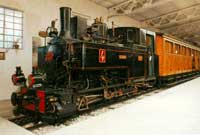 |
|
| Abdul Aziz Athenian tramways of the past decades hand-and-foot operated draeseners models and photographic material instruments, printing implements, tickets, uniforms and mechanics' tools of the 19th century.
A steam locomotive and passenger car (rack railway of Diakofto-Kalavryta) built in France in 1899. |
|
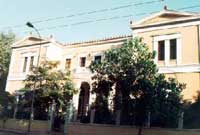 |
|
GALLERY OF THE MUNICIPALITY OF ATHENS
The Municipal Gallery of Athens is housed in a neoclassical building, on Koumoundourou Square, built on the plans of the architect Panagis Kalkos in 1874.
The inauguration of the Gallery took place on the 22nd of September, 1982. Before that, the collection had been housed, since 1974, in the Cultural Center of the Municipality, on Acadimias Street. |
|
| The Municipality of Athens began to put together its artist collection in 1923. The first work it bought was the sculpture by D.
Philippotis, "The Fisherman", and it is interesting to note that half of the 2,355 works of art which the Gallery counts among its collection, were acquired during the period 1930-1940. Almost all the Greek artists, whose creations marked the history of Greek art and who contributed to its development in the 20th century, are represented by some of their important works in the collection of the Municipal Gallery.
Among its most interesting features are the collection of engravings, with works by the great masters of this art and their worthy followers, but also of works by young engravers; the full representation of the generation of artists of the '30s; the collection of works by the famous architect,
Ziller, which are of artistic and historical interest, and among which are 56 drawings of the National Theatre, the Municipal Theatre, as well as of private homes; also the paintings of ruins by V. Lanza; the portraits of Mayors and Presidents of Municipal Councils painted by masters of the style
(Tsokos, Kalloudis, Iakovides) and a large number of drawings of the Arts Sanctuary inspired from the Athens of their time.
|
|
WAR MUSEUM OF ATHENS
The Museum was inaugurated in 1975. Its aim and mission is the exhibition of war
mementoes, the documentation and study of war history as well as the presentation of the
struggles for freedom of the Greek nation from ancient times to the present day. The permanent exhibition area of the Museum includes Room 1, which is devoted to antiquity and covers the Stone Age |
|
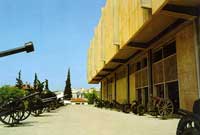 |
|
| and the Early Bronze Age, with an emphasis on the Mycenean era; Room 2, in which themes from the prehistory of Greece are presented through groups of photographs or drawings; Room 3 presents the Byzantine period, Room 4 the period of Frankish rule, Rooms 5-6 the Greek War of
Independence, Room 7 the new Greek State, Room 8 is devoted to the 1912-1913 Balkan Wars, Room 9 to the Balkan Wars and the First World War, room 10 to the historic period of the Greco-Italian War of 1941-1941 and the German invasion. On the mezzanine, the room is devoted to the first Greek airmen and the ground floor to the P. Saroglou collection. There is also an important and well-organized library in the Museum. |
|
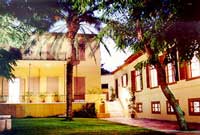 |
|
MUSEUM OF POPULAR INSTRUMENTS
Research Center for Ethnomusicology
The Museum of Popular Instruments - Research Center for Ethnomusicology (MELMOKE) comprises the collection of about 1200 Greek popular musical instruments dating from the 18th century to the present day, the fruit of a half century of research and study |
|
| by the musicologist Fivos Anoyanakis. The Museum is housed in the historical Lassanis Mansion, which was built in 1842 close to the Roman Agora. |
|
ARCHAEOLOGICAL MUSEUM OF PIRAEUS
The first Museum was founded in 1935. The extension of the new Piraeus
Museum was carried out in 1966. The Museum collections include the following:
A fine collection of sculptured grave monuments of the 5th and 4th centuries B.C. |
|
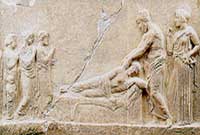 |
|
Dedicatory reliefs of the 5th and 4th centuries B.C. from Piraeus.
A statue of the Mother of the Gods of the 4th century B.C. from Moschato and a shrine (naiskos) from Piraeus.
Bronze statues of the Classical period from Piraeus.
Pottery from excavations in Piraeus, Salamis and the west coast.
Hellenistic and Roman sculpture from Piraeus.
Neoattic relief plaques from a shipwreck of the 2nd century A.C.
In the picture dedicatory relief to Asklepios, 4th century B.C. |
|
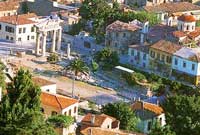 |
|
ROMAN AGORA OF ATHENS
Large building measuring 111 x 98 m., comprising a spacious rectangular courtyard surrounded by stoas, shops and storerooms. It has an east, Ionic propylon and a west, Doric propylon, known as the Gate of Athena Archegetis. It was built between 19 and 11 B.C. with a donation of Julius Caesar and Augustus. |
|
| During the reign of Hadrian the court was paved with slabs. After the invasion of the Herulae in A.D. 267 the city of Athens
was restricted to the area within the Late Roman fortification wall, and the administrative and commercial center of the city was transferred from the Ancient Agora to the Roman Agora and the Library of Hadrian. During the Byzantine period and the Turkish occupation the area was covered with houses, workshops and churches along with the Fethiye Mosque. |
|
THE ILIAS LALAOUNIS JEWELRY MUSEUM
The Ilias Lalaounis Jewelry Museum (ILJM) is a center for international jewelry studies. On permanent display are the creations by Ilias Lalaounis, an Athenian jeweler and goldsmith, elected member to the French Academie des Beaux-Arts. The Museum
organizes temporary exhibitions on various aspects of modern or antique jewelry and runs a series of educational and cultural |
|
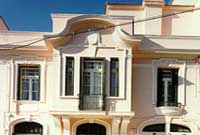 |
|
| activities. The ILJM operates as a non-profit cultural institution; following the combined approval of the Ministry of Culture and the Ministry of Finance the Museum is a registered charity. The ILJM opened to the public in December 1994. It is housed in the old Ilias Lalaounis workshop on the south slope of the
Acropolis. The building, a beautiful 1930s house, was renovated by Vassilis Gregoriadis on plans prepared by Bernard Zehrfuss. |
|
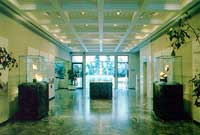 |
|
MUSEUM OF CYCLADIC ART
The Nicholas P. Goulandris Foundation - Museum of Cycladic Art
The Museum of Cycladic Art was founded in 1986 in order to house the collection of Cycladic and Ancient Greek art belonging to Nicholas and Aikaterini Goulandris. A new building was designed and |
|
| erected for that purpose in thecentre of Athens, on 4 Neophytou Douka Str. Since 1991 the Museum has acquired a new wing, the magnificent neo-classical Stathatos House on the corner of Vassilissis Sophias and Herodotou Streets. |
|
THE SOUTH SLOPE OF THE ACROPOLIS
The south slope of the Acropolis played a significant role in the artistic, spiritual and religious activity of ancient
Athens. Important public buildings were erected in the area: the Odeion of Perikles, the sanctuary and theatre of Dionysos, the choregic monuments, the Asklepieion, the stoa of Eumenes and the Odeion of Herodes Atticus. |
|
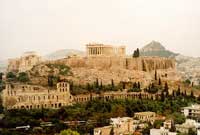 |
|
| Recently, architectural members in the orchestra and the retaining wall of the east parodos of the Dionysos Theatre were restored. Excavations at the sanctuary of Dionysos started in 1838 by the Greek Archaeological Society and lasted for about a century. They brought to light the theatre and the greater part of the sanctuary which includes the two temples of
Dionysos.
The excavations at the Odeion of Perikles were carried out almost sixty years ago and revealed a large building with many columns. The excavations, conducted by Kastriotes (1914-1927) and Orlandos (1928-1931), revealed the north side of the building and five column bases at the NE corner. The excavations at the Asklepieion were conducted in 1875-76 by the Greek Archaeological Service under the direction of St. Koumanoudis and uncovered the Early Christian basilicas and remains of the most important buildings of the sanctuary. |
|
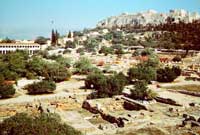 |
|
THE ANCIENT AGORA OF ATHENS
The Agora was the heart of ancient Athens, the focus of political, commercial, administrative and social activity, the religious and cultural
center, and the seat of justice. The site was occupied without interruption in all periods of the city's history. It was used as a residential and burial area as early as the Late Neolithic period (3000 B.C.). |
|
| Early in the 6th century, in the time of Solon, the Agora became a public area. After a series of repairs and
remodeling, it reached its final rectangular form in the 2nd century B.C. Extensive building activity
occurred after the serious damage made by the Persians in 480/79 B.C., by the Romans in 89 B.C. and by the Herulae in A.D. 267 while, after the Slavic invasion in A.D. 580, It was gradually abandoned. From the Byzantine period until after 1834, when
Athens became the capital of the independent Greek state, the Agora was again developed as a residential area. |
|
THE PNYX
The function of the large, theatre-like area on the hill west of the Acropolis had, in the past, been explained by a number of different theories, before it was securely identified as the Pnyx, the place where the Assembly of the Athenians held its meetings. The remains found have shown that the Pnyx had three main building periods. |
|
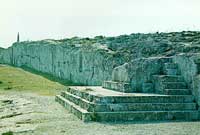 |
|
| In the first period, the natural hillside was used as the cavea of the theatre. The surface was evened off by quarrying out the hard limestone, while a straight retaining wall was built on the north side. In the second period, the arrangement of the auditorium was very different; a high, semicircular retaining wall was built to the north, supporting an
embankment sloping down to the south, that is, in the opposite direction comparing to the first period. The approach was through the two stairways, 3.90 m. wide. The Pnyx of the third period had exactly the same plan but on a larger scale; the great retaining wall was constructed of large stone blocks quarried from the area, while the new bema was arranged to the south. |
|
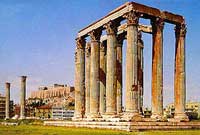 |
|
OLYMPIEION
According to tradition, the establishment of the sanctuary goes back to the time of mythical Deucalion. The site was inhabited in the prehistoric period and the cult of Zeus is attested in early historic times. In ca. 515 B.C., Peisistratos the Younger, began the construction of a monumental temple which was not finished because of the fall of the tyranny in
Athens. |
|
| Much later, in 174 B.C., Antiochos IV Epiphanes, the king of Syria, attempted to continue the erection of the temple, which was finally completed by the Roman emperor Hadrian, in A.D. 124/125. Inside the temple stood a colossal chryselephantine (gold and ivory) statue of Zeus.
The temple was excavated in 1889-86 by E. Penrose, and in 1922 by G. Welter. The Greek Archaeological Society conducted excavations in the area around the temple, between 1886 and 1907, and work was resumed by Ioannes Travlos in the 1960's.
Many parts of the circuit wall of the sanctuary have been rebuilt, imitating the ancient masonry. Sections of the ancient wall have been preserved only at the south-east corner and on the north side. |
|
|
 |
|
|
|